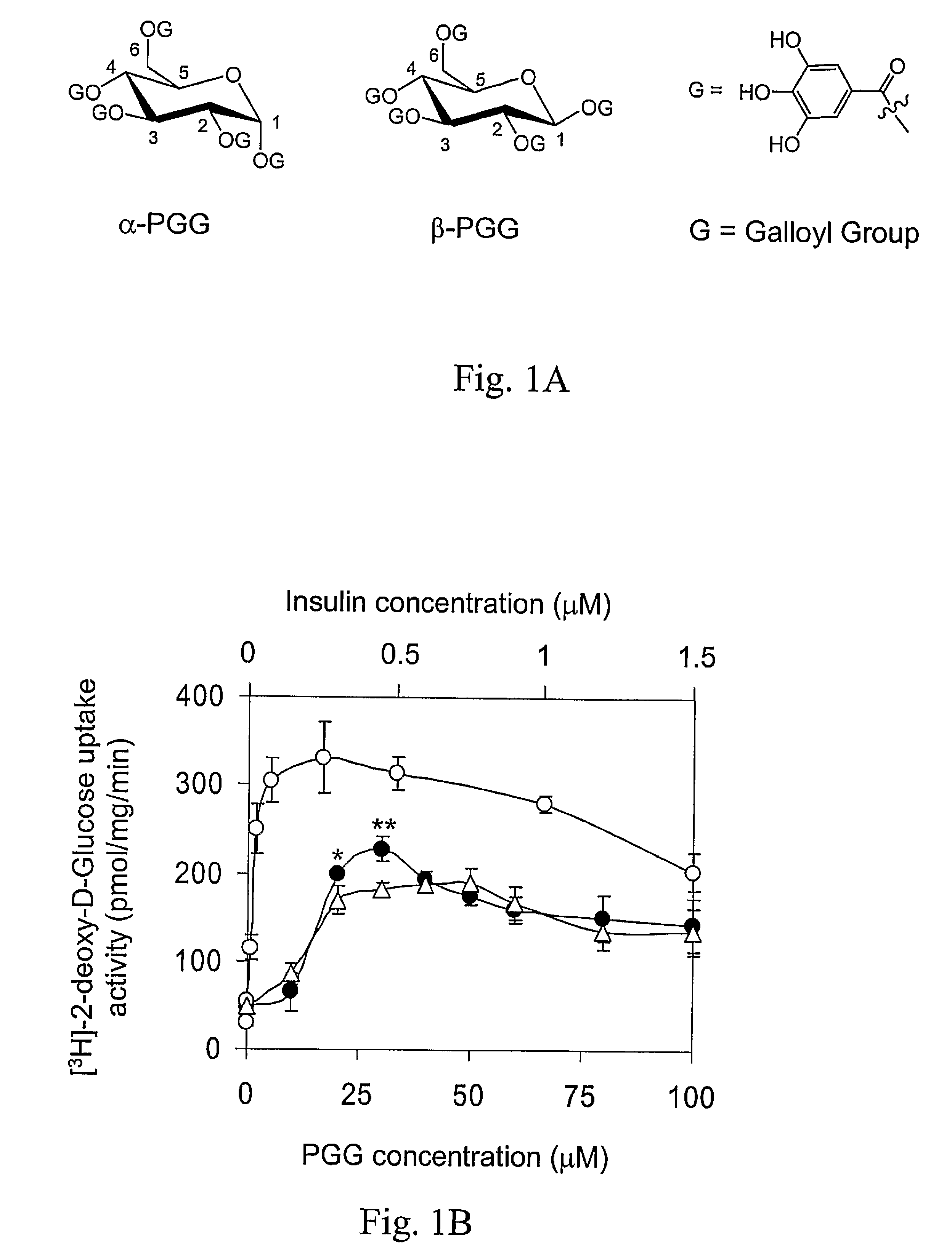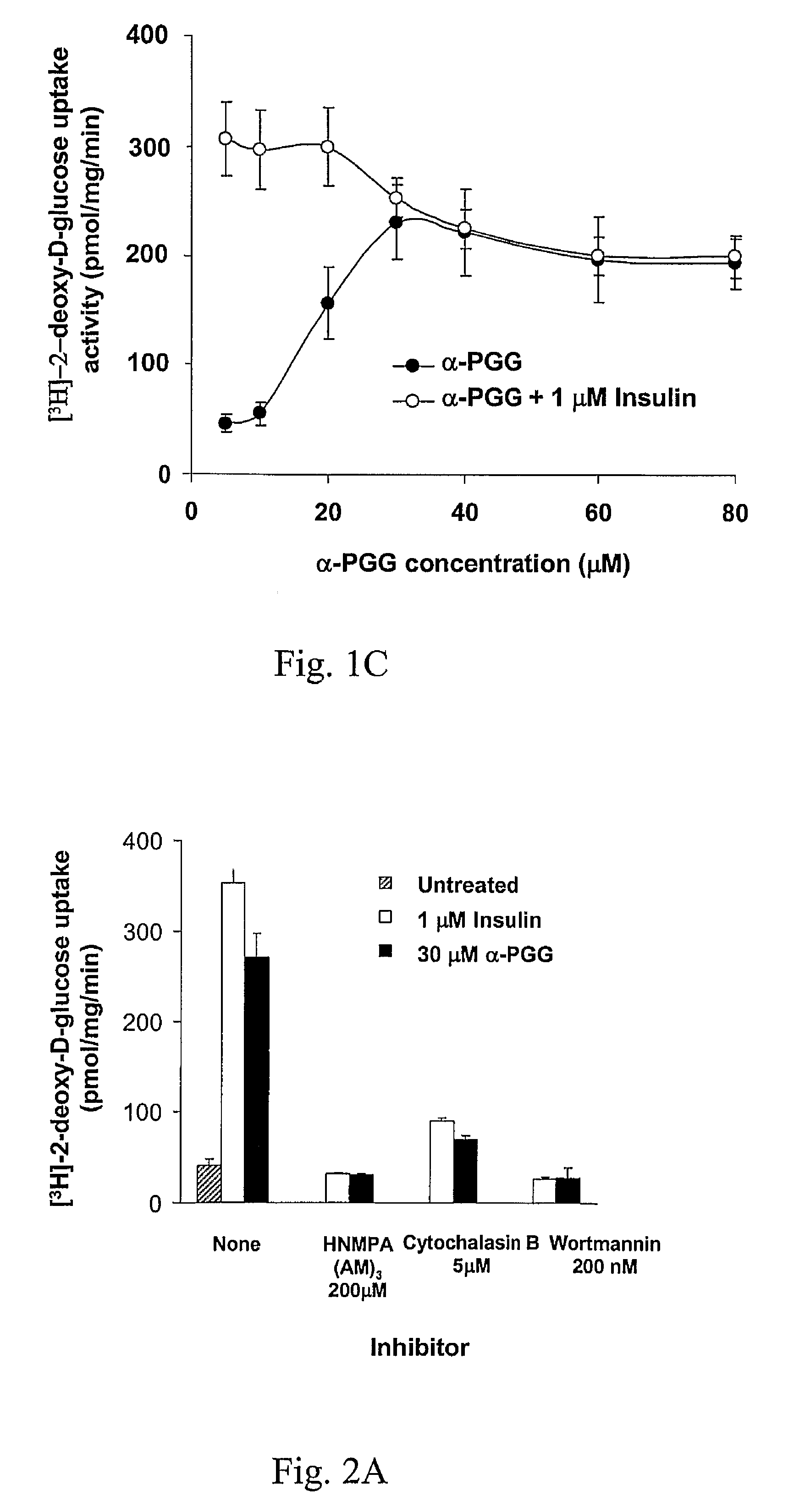Methods for identifying insulin mimetics
a technology of insulin mimetics and peptides, applied in the field of methods for identifying insulin mimetics, can solve the problems of impaired glucose tolerance, increased and premature mortality, uncontrollable hyperglycemia,
- Summary
- Abstract
- Description
- Claims
- Application Information
AI Technical Summary
Problems solved by technology
Method used
Image
Examples
example 1
α- and β-PGG Stimulate Glucose Transport in 3T3-L1 Adipocytes
[0047]The approximately equimolar mixture of α- and β-PGG (22, FIG. 1A) was synthesized. The compounds were chromatographically separated, and tested individually. α-PGG and β-PGG induced glucose transport in adipocytes in a dose-dependent manner (FIG. 1B). At the 15-30 μM concentration range, α-PGG was consistently 10-20% more active than β-PGG (FIG. 1B, P<0.05 at 15 μM, and P<0.01 at 30 μM). The difference in activity may be accounted for by the structural differences around the anomeric carbon (carbon-1) of the glucose core of the molecules (FIG. 1A). The estimated EC50 for glucose transport activity for α-PGG was 13 μM±2 μM. Since α-PGG showed a higher activity than the β-anomer, it was chosen as our lead compound for the following studies. Addition of α-PGG to insulin reduced the glucose transport activity induced by insulin towards that of α-PGG (FIG. 1C). This result indicates that α-PGG-induced glucose transport ac...
example 2
α-PGG Activates Protein Factors Involved in the Insulin-Mediated Glucose Transport Signaling Pathway
[0048]Molecular and cellular studies were initiated to test the hypothesis that PGG activates the insulin-mediated glucose transport signaling pathway. The glucose transport activity induced by α-PGG in adipocytes was completely abolished in the presence of the insulin pathway inhibitors HNMPA-(AM)3, wortmannin, or cytochalasin B (FIG. 2A). Importantly, HNMPA-(AM)3, which inhibits the tyrosine kinase of IR, also completely blocked the activity of α-PGG (FIG. 2A). This result suggests that the target of α-PGG's glucose transport induction is IR, not protein factors downstream from IR. Protein studies revealed that α-PGG induces the phosphorylation of the IR (FIG. 2B) and activates PI-3 kinase (FIG. 2C) in CHO-IR cells, which express significantly more IR than 3T3-L1 adipocytes. It was further shown that Akt was phosphorylated in 3T3-L1 adipocytes in a dose-dependent fashion (FIG. 2B). ...
example 3
α-PGG Binds to Insulin Receptor and Affects Insulin-IR Binding
[0049]SPR study results indicate that α-PGG binds to pure IR with an apparent binding affinity (Kd) of 43±2 μM (FIG. 3A). Together with the findings that α-PGG stimulates insulin-like glucose transport activity (FIG. 1B) and activates protein factors, including IR, involved in the insulin-mediated glucose transport signaling pathway in adipocytes (FIG. 2), this result further supports that the target of α-PGG's glucose transport induction in adipocytes is the IR. The maximal binding (Bmax) for insulin was reduced in a dose-dependent manner with increasing amounts of α-PGG without significantly affecting the Kd (FIG. 3B). This result indicates that α-PGG affected the total binding of insulin without altering insulin's binding affinity to the IR. α-PGG did not bind to insulin, and the inhibitory effect on insulin binding was not a result of α-PGG-insulin binding.
[0050]The notion that α-PGG affects insulin-IR binding was fur...
PUM
| Property | Measurement | Unit |
|---|---|---|
| volume | aaaaa | aaaaa |
| pH | aaaaa | aaaaa |
| pH | aaaaa | aaaaa |
Abstract
Description
Claims
Application Information
 Login to View More
Login to View More - R&D
- Intellectual Property
- Life Sciences
- Materials
- Tech Scout
- Unparalleled Data Quality
- Higher Quality Content
- 60% Fewer Hallucinations
Browse by: Latest US Patents, China's latest patents, Technical Efficacy Thesaurus, Application Domain, Technology Topic, Popular Technical Reports.
© 2025 PatSnap. All rights reserved.Legal|Privacy policy|Modern Slavery Act Transparency Statement|Sitemap|About US| Contact US: help@patsnap.com



